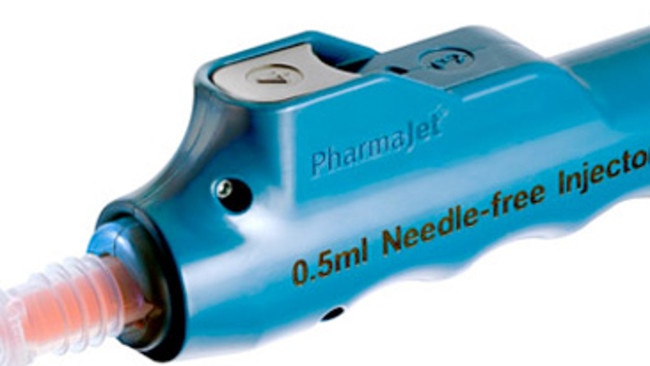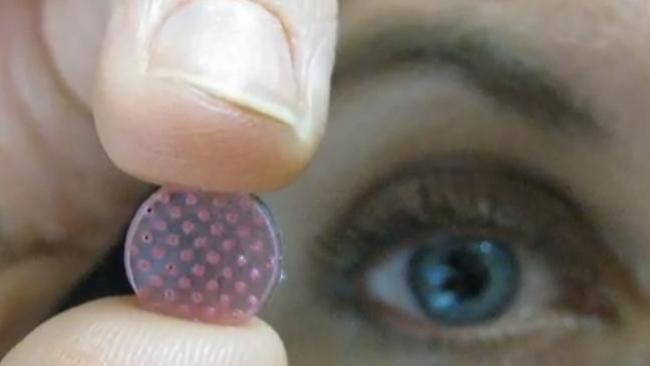Vaccinations without the pain of a needle prick are on the way
EVERY parent fears the pain their child experiences when getting vaccinated. But what if there was another, needle-free method of vaccinating children?

THE tears all new parents fear at immunisation time are set to become history with research teams racing to produce needle-less vaccines.
Australian researchers will later this year begin clinical trials in adults of a Nanopatch to deliver vaccines through a tiny patch on the skin.
And in the United Kingdom, researchers are working on a “sugar pill” delivery method using vaccines dried in sugar and shaped into a tiny disc covered in microneedles of sugar that dissolve when inserted into the skin.
A needle free version of the flu vaccine went on sale in the United States last year.
Doctors administer the vaccine using an injector device that delivers the vaccine by a high pressure inoculation that punches the skin with a concentrated spray.
The Pharmajet manufacturers partnered with Australian vaccine company CSL, but that the vaccine producer says the needle free technology won’t be used in Australia.

“We don’t use the multi dose vials in Australia so at this stage its not available here,” a CSL spokeswoman said.
However, the company says it is exploring other delivery technologies with potential Australian collaborators.
WHOOPING COUGH vaccine wears off early
VACCINATE or lose government rebates
It may be minus the pain of a skin prick but the US Food and Drug Administration noted Pharmajet wasn’t free of irritation.
“Injection related side effects were reported more frequently by those individuals who received Affluria via the PharmaJet Stratis Needle-Free Injection System than those individuals who received Affluria by a sterile needle and syringe,” the agency noted.

Developed by University Queensland bioengineer Professor Mark Kendall, the Nanopatch is a one centimetre square of silicone, studded with 20,000 vaccine coated micro projections that perforate the skin.
The patch activates key immune cells immediately below the skin to generate immunity.
Tests on mice showed the device increased the immune response in mice and could mean less vaccine was needed.
Venture capital company Vaxxas has just raised $25 million to run clinical programs that will develop new vaccine products for major diseases using the Nanopatch.
The company is also working with pharmaceutical company Merck, a major vaccine producer which makes versions key childhood vaccines including measles, mumps, rubella, rotavirus, chickenpox, meningococcal, HIB and hepatitis B and pneumococcal vaccine.

It also produces the cervical cancer vaccine given to teenage boys and girls in Australia.
It won’t say which of these vaccines will be trialled with the Nanpopatch but Vaxxas says in animal testing the Nanopatch was applicable to all the types of vaccines.
The World Health Organisation is funding research to use the Nanopatch with polio vaccine.
A spokesman for Vaxxas said if trials that begin this year are successful, the Nanopatch vaccines could be on the market within five years.
“All going well, we could potentially have Nanopatches available for vaccinations as a product by 2020,” the spokesman said.
Scientists at Kings College London are working on a similar idea that uses a dried live vaccine applied to the skin in immunisation.

The research funded by the Bill and Melinda Gates Foundation uses vaccines dried in sugar and shaped into a tiny disc covered in microneedles of sugar that dissolve when inserted into the skin.
A dried version of a live virus is put into the sugar and when applied to mice it was picked up by dendritic cells in the skin responsible for triggering an immune response.
The immune response it generated in the mice was similar to using the same amount of injected liquid vaccination.
The new vaccine delivery methods don’t just eliminate the pain of needles they remove the risk of needle stick injuries and have the advantage they don’t need to be stored in refrigerators.
In time it is possible the new delivery methods could be used to treat Type 1 diabetes and other illnesses that require injectable treatment.




